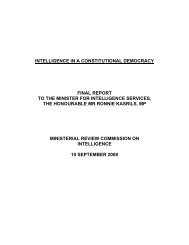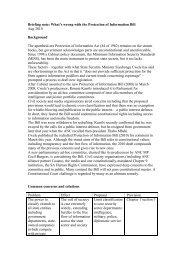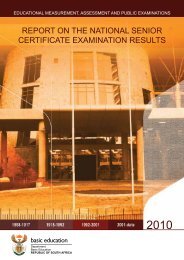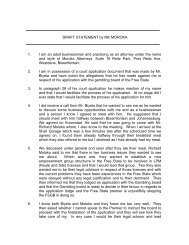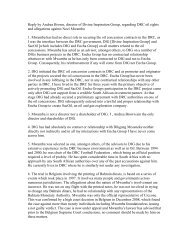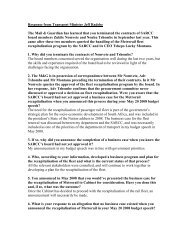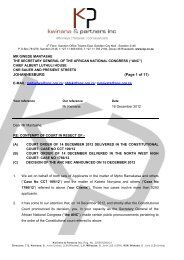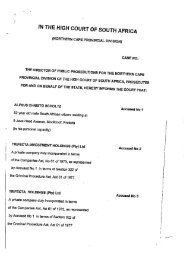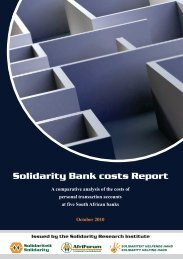Report on the National Senior Certificate Examination Results 2010.
Report on the National Senior Certificate Examination Results 2010.
Report on the National Senior Certificate Examination Results 2010.
Create successful ePaper yourself
Turn your PDF publications into a flip-book with our unique Google optimized e-Paper software.
REPORT ON THE NATIONAL SENIOR CERTIFICATE EXAMINATION RESULTS • 2010<br />
2.7 Processing of marks and results <strong>on</strong> <strong>the</strong> Integrated Examinati<strong>on</strong> Computer<br />
System (IECS)<br />
The Integrated Examinati<strong>on</strong> Computer System (IECS) c<strong>on</strong>stitutes <strong>the</strong> backb<strong>on</strong>e of <strong>the</strong> examinati<strong>on</strong> system.<br />
<strong>the</strong> iEcs is <strong>the</strong> system utilised for <strong>the</strong> registrati<strong>on</strong> of candidates and centres, provisi<strong>on</strong> of printing and packing<br />
statistics, <strong>the</strong> capture, processing and release of results . <strong>the</strong> dbE commenced with <strong>the</strong> development of this<br />
new computer system in 2007, in preparati<strong>on</strong> for <strong>the</strong> new curriculum. The IECS has successfully processed<br />
<strong>the</strong> results of candidates in <strong>the</strong> 2008 and 2009 NSC examinati<strong>on</strong>. Over <strong>the</strong> last two years, <strong>the</strong> shortcomings of<br />
<strong>the</strong> IECS were identified and enhancements were implemented in <strong>2010.</strong> To ensure a foolproof system for <strong>the</strong><br />
processing of <strong>the</strong> NSC results in 2010, <strong>the</strong> IECS has been implemented <strong>on</strong> a sec<strong>on</strong>d platform which is based<br />
<strong>on</strong> a mainframe system . <strong>the</strong> dbE will c<strong>on</strong>tinue with <strong>the</strong> enhancements of <strong>the</strong> iEcs in future years and <strong>the</strong> full<br />
potential of <strong>the</strong> system will be realised <strong>on</strong>ce each school and each district in <strong>the</strong> country has direct access to<br />
<strong>the</strong> examinati<strong>on</strong> data for purposes of ensuring effective data collecti<strong>on</strong> and promoting regular and effective<br />
feedback .<br />
2.8 Standardisati<strong>on</strong> of <strong>the</strong> NSC <strong>Results</strong><br />
umalusi, <strong>the</strong> council for Quality assurance in General and Fur<strong>the</strong>r Educati<strong>on</strong> and training, is resp<strong>on</strong>sible for<br />
<strong>the</strong> standardisati<strong>on</strong> of <strong>the</strong> examinati<strong>on</strong> results. Standardisati<strong>on</strong> is an educati<strong>on</strong>al process practiced world over,<br />
which is meant to normalise examinati<strong>on</strong> scores of candidate’s through a process based <strong>on</strong> sound educati<strong>on</strong>al<br />
reas<strong>on</strong>ing as well as comparis<strong>on</strong>s of <strong>the</strong> current and previous year’s marks. Despite <strong>the</strong> fact that questi<strong>on</strong><br />
papers are moderated internally by <strong>the</strong> DBE and externally by Umalusi, <strong>the</strong> standard of <strong>the</strong> questi<strong>on</strong> paper<br />
<strong>on</strong>ly becomes evident after <strong>the</strong> examinati<strong>on</strong> is written and <strong>the</strong> learner resp<strong>on</strong>ses are marked. Therefore, <strong>the</strong><br />
examinati<strong>on</strong> scores of <strong>the</strong> current year must be compared to previous years so as to ensure that a candidate<br />
writing <strong>the</strong> examinati<strong>on</strong> in 2010 is nei<strong>the</strong>r advantaged nor disadvantaged.<br />
The objectives of standardisati<strong>on</strong> process are to:<br />
(a) ensure that <strong>the</strong> cohort of learners is not duly or unduly advantaged by fluctuati<strong>on</strong>s of results;<br />
(b) ensure that a c<strong>on</strong>sistent quality is produced over <strong>the</strong> years;<br />
(c) mitigate fluctuati<strong>on</strong>s of learner performance as a result of factors o<strong>the</strong>r than learner performance.<br />
The 2010 standardisati<strong>on</strong> process was c<strong>on</strong>ducted under rigorous and robust c<strong>on</strong>diti<strong>on</strong>s following <strong>the</strong> principles<br />
which have been approved by <strong>the</strong> Umalusi Council to guide this process. They are as follows:<br />
(a) In general no adjustment should exceed 10% or <strong>the</strong> historical average<br />
(b) Adjustment in excess of 10% could be c<strong>on</strong>sidered at <strong>the</strong> upper end to increase <strong>the</strong> number of distincti<strong>on</strong>s<br />
in a subject<br />
(c) In <strong>the</strong> case of individual candidates, <strong>the</strong> adjustment effected should not exceed 50% of <strong>the</strong> mark obtained<br />
by <strong>the</strong> candidate .<br />
(d) if <strong>the</strong> distributi<strong>on</strong> of <strong>the</strong> raw marks is below <strong>the</strong> historical average, <strong>the</strong> marks may be adjusted upwards,<br />
subject to <strong>the</strong> limitati<strong>on</strong>s .<br />
(e) <strong>the</strong> computer adjustment mark is calculated based <strong>on</strong> <strong>the</strong> above principles .<br />
(f) For those subjects with a practical comp<strong>on</strong>ent of 50%, raw marks could be accepted.<br />
21



